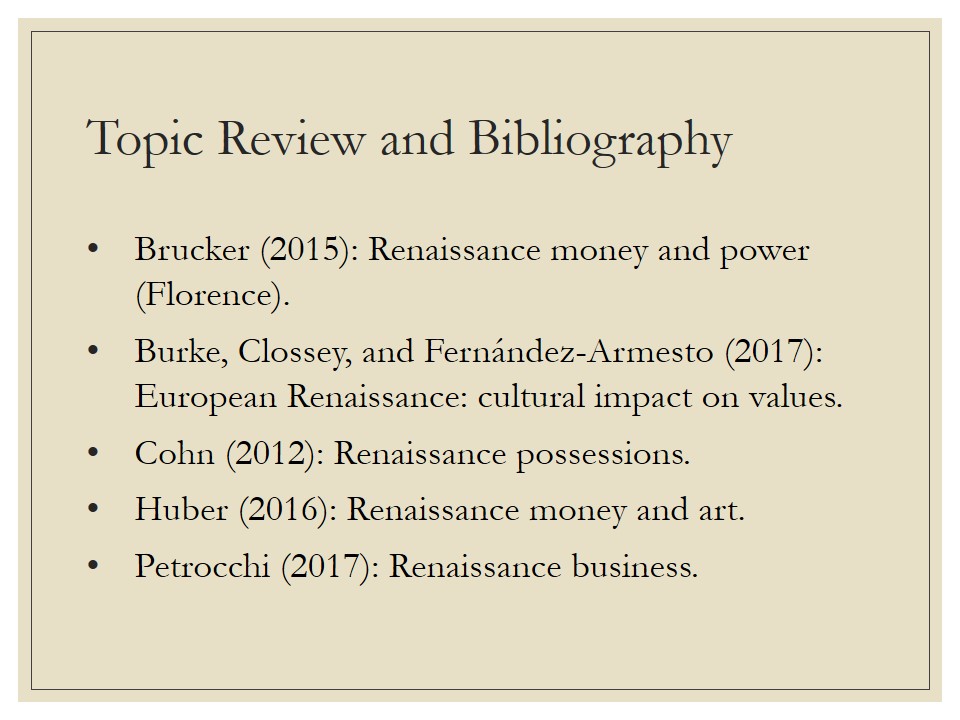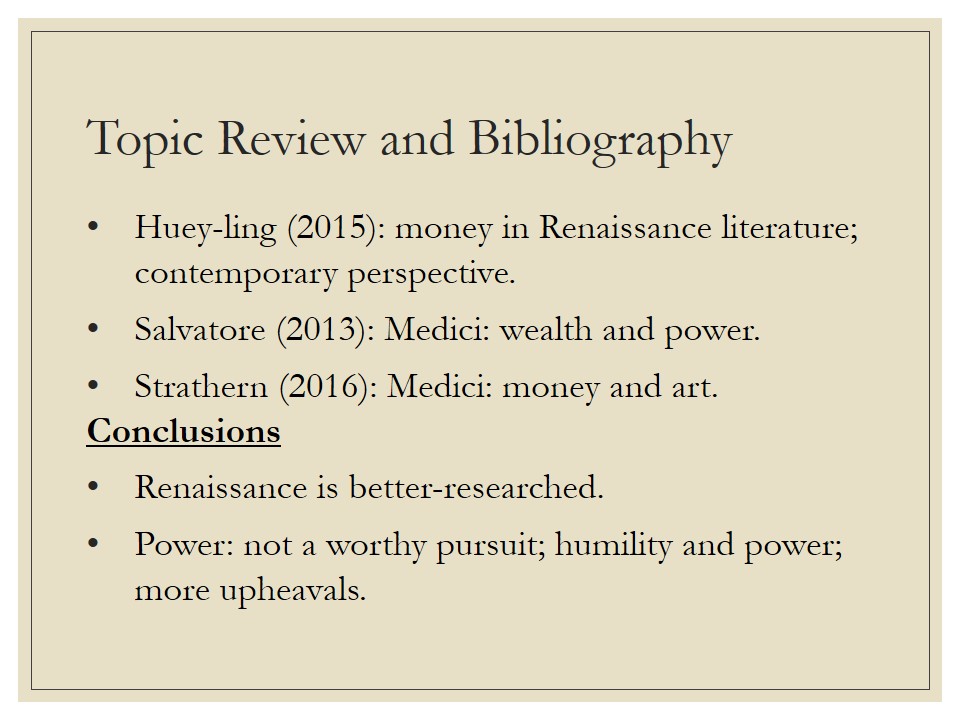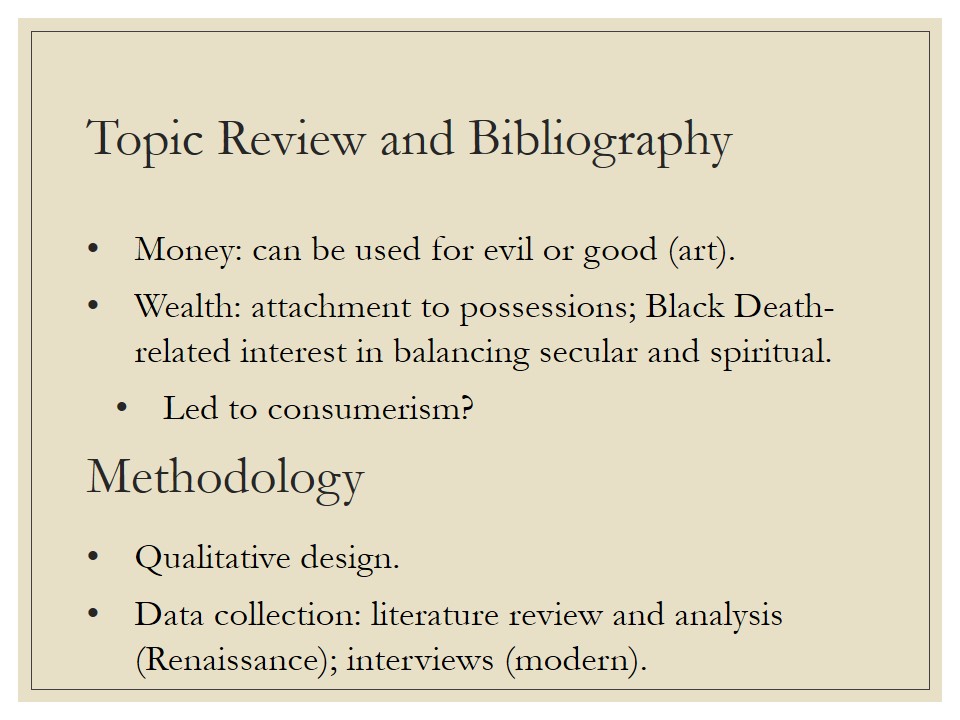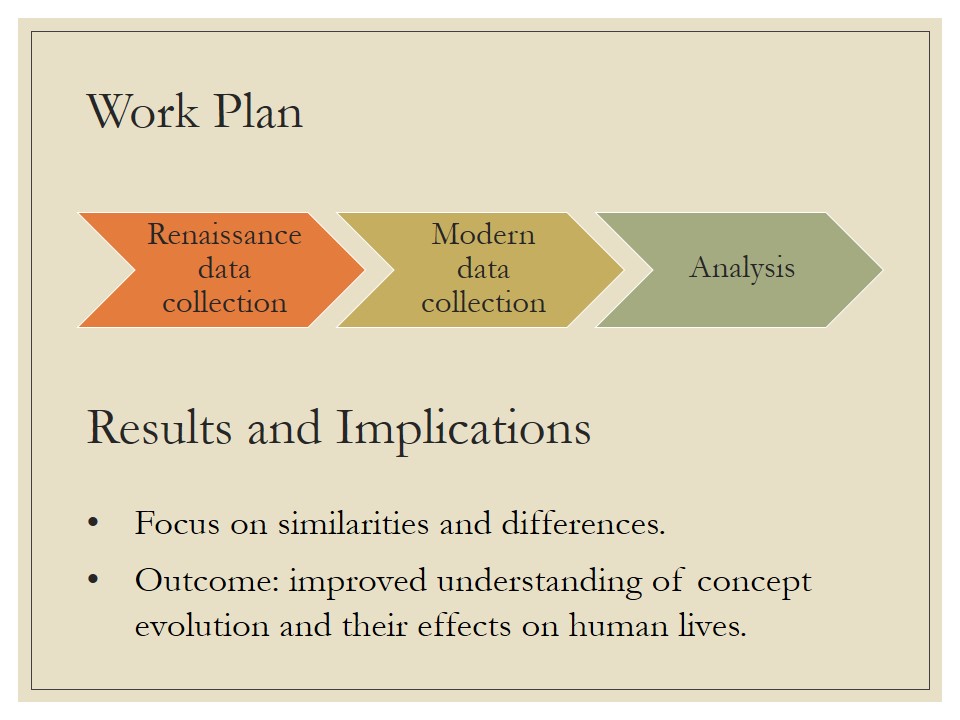The presented project is devoted to comparing the perceptions that can be viewed as dominant for Early Renaissance and modern people. In particular, the perceptions related to the topics of money, wealth, and power are of interest. This project can provide insights into the evolution of mindsets and improve our understanding of modern views.
Topic Review and Bibliography
- Brucker (2015): Renaissance money and power (Florence).
- Burke, Clossey, and Fernández-Armesto (2017): European Renaissance: cultural impact on values.
- Cohn (2012): Renaissance possessions.
- Huber (2016): Renaissance money and art.
- Petrocchi (2017): Renaissance business.
- Huey-ling (2015): money in Renaissance literature; contemporary perspective.
- Salvatore (2013): Medici: wealth and power.
- Strathern (2016): Medici: money and art.
This slide describes some of the modern literature that will be employed in the project. For example, Brucker (2015) discusses the Renaissance notions of money and power in Florence. Similarly, Burke, Clossey, and Fernández-Armesto (2017) focus on the European Renaissance values in general. Also, the authors demonstrate the fact that Renaissance values may have been influenced by culture. Cohn (2012), Huber (2016), and Petrocchi (2017) discuss money and wealth to some extent: in the form of possessions or business in general and in relation to art.
Strathern (2016) also considers the relationship between money and art, using the House of Medici as an example. Salvatore (2013) also considers the House of Medici and related values of wealth and power. Finally, Huey-ling’s (2015) work introduces the modern perspective on the topic of money in Renaissance literature.
Conclusions
- Renaissance is better-researched.
- Power: not a worthy pursuit; humility and power; more upheavals.
- Money: can be used for evil or good (art).
- Wealth: attachment to possessions; Black Death-related interest in balancing secular and spiritual.
- Led to consumerism?
In sum, it seems that the topic of Renaissance values is well-researched, but they are rarely compared to the modern-day perspective. Still, some conclusions can be drawn from the information provided. For example, in the Renaissance period, power was a questionable pursuit and could be viewed as less stable due to more frequent upheavals (Salvatore, 2013). Also, Salvatore (2013) reports that the period’s population saw a connection between humility and power, suggesting that the former can be the basis of the latter. This view appears to be rather foreign to the modern world.
According to Huber (2016), the concept of money in the Renaissance era included the perception that it could be used for good or evil, and the good usage of money could be related to artist encouragement. As for wealth, Cohn (2012) highlights the importance of the aftermaths of the Black Death for the people of Renaissance: the tragedy taught them to be attached to their possessions and seek a balance between secular and spiritual life. In general, the above-mentioned perceptions on money and wealth are rather familiar to the modern people and might have been connected to the more modern mindset of consumerism. The search for such similarities and differences is the aim of the project.
Methodology
- Qualitative design.
- Data collection: literature review and analysis (Renaissance); interviews (modern).
The project is going to work with qualitative data, which is why its design is qualitative. The data collection tools will be defined by the specifics of the data: the Renaissance information is likely to be gleaned from literature reviews and analysis, but modern information can be gathered from interviews with modern people.



Work Plan
Renaissance data collection → Modern data collection → Analysis.
The plan of the work involves two stages of data collection (one for each period) and their analysis. Before the process, the project plan will be finalized and approved; after it, the final report will be prepared.
Results and Implications
- Focus on similarities and differences.
- Outcome: improved understanding of concept evolution and their effects on human lives.
The results of the project will focus on the similarities and differences that can be spotted between the periods and their values. These results will be employed to enhance our understanding of the evolution of the mentioned concepts and the effects of the Renaissance period on modern perceptions.

References
Brucker, G. A. (2015) The civic world of Early Renaissance Florence. Princeton, NJ: Princeton University Press.
Burke, P., Clossey, L., & Fernández-Armesto, F. (2017). The global Renaissance. Journal of World History, 28(1), 1-30.
Cohn, J. S. (2012). Renaissance attachment to things: Material culture in last wills and testaments. Economic History Review, 65(3), 984-1004.
Huber, R. (2016). Oh death: Death, dying, and the culture of the macabre in the late Middle Ages. Web.
Huey-ling, L. (2015). The social meaning of money in Dekker’s The Shoemaker’s Holiday and Shakespeare’s The Merchant of Venice. Comparative Drama, 49(3), 335-366.
Petrocchi, A. (2017). Mercantile arithmetic in Renaissance Italy: A translation and study of a vernacular abbaco work. Ceræ: An Australasian Journal of Medieval and Early Modern Studies, 3, 1-30.
Salvatore, C. (2013). “God, power and money:” Did Cosimo de’Medici deceive Renaissance Florence? Intersedes, 14(29), 180.
Strathern, P. (2016). The Medici: Power, money, and ambition in the Italian Renaissance. New York, NY: Pegasus Books.